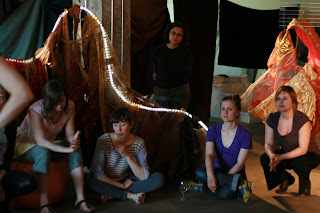


























INTO THE FOLDS ~ May 23-24
SLOW CLOTHES ~ May 25
*all events will take place at the Société des arts technologiques, 1197
* the event asks for continued participation through all activities except the keynote and early-bird yoga sessions
*
| MAY 22 arrivals | Many of us will likely be working in the SAT space, so feel free to come and hang out! Just ring the doorbell and go to the back of the space to Art & D and peak in. |
| MAY 22 – 7pm | Steven Shaviro – keynote on Whitehead and Deleuze |
| May 23 – 9am (pre-event – come if you want! – coffee available for those who don’t do the yoga) | Yoga (with Gwendolyn Alker) |
| May 23 – 9:45 am | Introductions |
| May 23 – 10am | Relational Movement 1 (with Erin Manning and Mireille Painchaud) |
| May 23 – 12-1:30pm | LUNCH – provided |
| May 23 – 1:00 | Rebel Clown Army Games (Micha Cardenas) |
| May 23 – 1:30 | From Preacceleration to Inflexion |
| May 23 – 3:30 | Nibble Break |
| May 23 – 4pm | Relational Movement 2 (with Sher Doruff) |
| May 24 – 9 am (pre-event) | Yoga (with Gwendolyn Alker) |
| May 24 – 10 am | Conceptual Speed Dating |
| May 24 – 10:45 am | Concept Pods |
| May 24 – 12:00 | LUNCH - provided |
| May 24 – 1:30 | Relational Movement 3 (with Erin Manning and Mireille Painchaud) |
| May 24 – 3:30 | From the Interval to the Fold |
| May 24 – 5:00 | Pods 2: How to create a platform for relation? |
| May 25 - | Pods 2 continued (this is open but feel free to use the space to continue to conceptualize and create your relational platform) |
| May 25 – 2-5pm | Slow Clothes |
Français ci-dessous
PRESS RELEASE
for immediate release

The Sense Lab presents:
Slow Clothes
a performance/installation event ~ Sunday May 25 2008, 2-5 pm
1197 St. Laurent, Société des arts technologiques, Art & D
Slow Clothes is a performance installation, a movement experiment, a fabric collection and an experience of tactility. It is a participatory event: people are invited to compose with fabric, to dress themselves, to move through the space, to eat and drink, to create mobile environmental platforms.
Slow Clothes is based on a fabric collection entitled Folds to Infinity. Fold to Infinity is composed of cut and serged pieces of infinitely connectable fabric (connectable through magnets, buttons, hooks, buttonholes, snaps).
The design of Folds to Infinity challenges:
1. the idea that clothing fits a pre-defined shape;
2. that clothing design must be modular with pieces patterned for standard assembly;
3. that clothing relates primarily to the individual body rather than relating the individual body to those around it and to their shared environment.
The complex connectivity and the relational environment of Slow Clothes transforms fashion from a passive fitting to an active composition.
Concept and Collection: Erin Manning
Mobile Architecture: Erin Manning, Jon Yu
Lighting:
Thanks to: The Sense Lab, Art & D
Contact: emanning@alcor.concordia.ca ; 514-313-9145
------------------------------------------------------------------------------------------
COMMUNIQUÉ DE PRESSE
pour diffusion immédiate

Le LaboSens présente
Slow Clothes
Une performance/installation ~ Dimanche 25 Mai 2008, 14h-17h
1197 St. Laurent, Société des arts technologiques, Art & D
Slow Clothes est une performance/installation, une expérimentation de mouvement, une collection de tissus et une expérience du toucher. C’est un évènement participatif : les gens sont invités à composer avec les tissus, à s’habiller, à bouger dans l’espace, à boire et manger, à créer des plateformes mobiles environnementales.
Slow Clothes est créé autour d’une collection intitulée Plis à l’infini. Plis à l’infini se compose de coupes de tissus capables d’être infiniment reliés (à l’aide d’aimants, de boutons, de boutonnières etc.).
Plis à l’infini remet en question:
1. l’idée que les vêtements dépendent d’un corps pré-défini (une forme, une grandeur)
2. que le design de vêtements doit être modulaire
3. que les vêtements sont confiés seulement à un individu au lieu de créer une relation entre l’individu et l’environnement.
La connectivité complexe et son environnement relationnel de Slow Clothes transforme la mode d’un modèle passif à une composition active.
Concept and Collection: Erin Manning
Mobile Architecture: Erin Manning, Jon Yu
Lighting:
Thanks to: The Sense Lab, Art & D
Contact: emanning@alcor.concordia.ca ; 514-313-9145


Till soon!